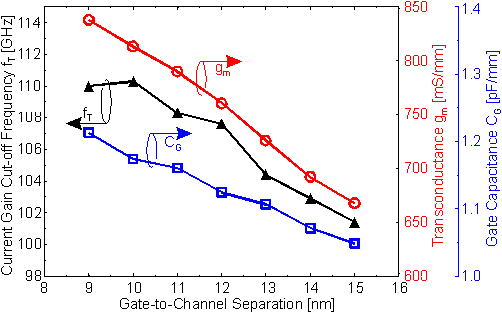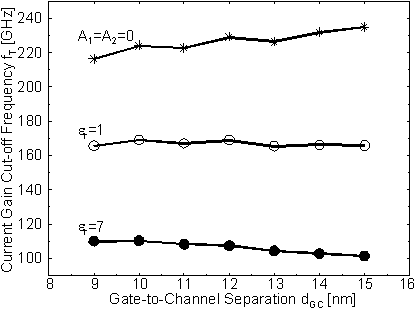
6.3.2.3 Dependence of fT
on dGC
It was shown in Figure
6.44 that fT can be increased for small LG
by a reduction of dGC. This is shown in more detail in
Figure
6.46 for the case LG = 120 nm. Although gm
is increased from 668 mS/mm for dGC = 15 nm to 838m S/mm
for dGC = 9 nm only a moderate improvement of fT
from 101 GHz to 110 GHz is obtained. This is due to the increase of CG
from 1.05 pF/mm to 1.21 pF/mm as depicted in Figure
6.46.

All three characteristics are expected to decrease monotonously thus, the local maximum in fT is believed to be result of some discretization error which is reflected in the CG(dGC) characteristics.
According to (62) CG
is the sum of three different contributions. The comparison between devices
with different dGC revealed that only A2
depends strongly on dGC. Thus the relative improvement
of fT versus dGC is dependent on the
ratio between the constant part of CG, i. e. ,
and the part dependent on dGC, i. e.
.
This is illustrated in Figure
6.47.

fT versus dGC for a passivated device is shown in Figure 6.47. In addition the fT for an unpassivated device is given. In this case fT is almost independent of dGC in the given range from dGC = 9 nm to dGC = 15 nm. A theoretical fT can be calculated by setting the constant contributions of CG to zero, i. e. A1 = A2 = 0 such that fT reduces to fT = gm/2pLGA3. This way the impact of dGC on gm and CG can be isolated. The slope of the corresponding characteristics is positive. In other words, A3 increases more rapidly with a reduction of dGC than gm.
This in turn explains the crossed fT(LG)
characteristics for the two different distances dGC.
For large LG the increase of CG overcompensates
the improvements in gm. For smaller LG
the quotient of the constant part of CG
over
is
increased such that the improvement in gm is not fully
compensated.
Helmut Brech 1998-03-11